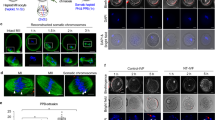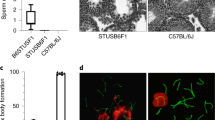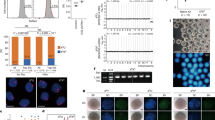Abstract
SUPEROVULATION through the administration of exogenous gonadotropins1 has been widely used in mice for experimental purposes, and cytogenetic evidence has shown2,4 that the technique does not affect adversely the chromosome constitution of either released ova or zygotes. We have noticed, however, that the incidence of triploidy increased considerably among zygotes obtained through superovulation followed by natural mating in adult A-strain mice5. We have therefore investigated the origin of the extra genome in such embryos.
This is a preview of subscription content, access via your institution
Access options
Subscribe to this journal
Receive 51 print issues and online access
$199.00 per year
only $3.90 per issue
Buy this article
- Purchase on Springer Link
- Instant access to full article PDF
Prices may be subject to local taxes which are calculated during checkout
Similar content being viewed by others
References
Fowler, R. E., and Edwards, R. G., J. Endocr., 15, 374–384 (1957).
Vickers, A. D., J. Reprod. Fert., 20, 69–76 (1969).
Donahue, R. P., Proc. natn. Acad. Sci. U.S.A., 69, 74–77 (1972).
Kaufman, M. H., J. Reprod. Fert., 35, 67–72 (1973).
Takagi, N., Chromosome Information Service, Tokyo, No. 11, 32 (1970).
Wroblewska, J., and Dyban, A. P., Stain Tech., 44, 147–150 (1969).
Takagi, N., and Oshimura, M., Expl Cell Res., 78, 127–135 (1973).
Schindler, A.-M., and Mikamo, K., Cytogenetics, 9, 116–130 (1970).
Beatty, R. A., Parthenogenesis and Polyploidy in Mammalian Development (Cambridge University Press, London, 1957).
Fischberg, M., and Beatty, R. A., Evolution, 6, 316–324 (1952).
Donahue, R. P., J. exp. Zool., 180, 305–318 (1972).
Edwards, R. G., J. exp. Zool., 138, 189–207 (1958).
Takagi, N., and Oshimura, M., Chromosome Information Service, Tokyo, No. 14, 36 (1973).
Wroblewska, J., Cytogenetics, 10, 199–207 (1971).
Fischberg, M., and Beatty, R. A., J. exp. Zool., 118, 321–336 (1951).
Edwards, R. G., and Fowler, R. E., J. exp. Zool., 141, 299–322 (1959).
McLaren, A., and Michie, D., J. exp. Biol, 36, 281–300 (1959).
Beaumont, H. M., and Smith, A. F., J. Reprod. Fert., 45, 437–448 (1975).
Fujimoto, S., Pahlavan, N., and Dukelow, W. R., J. Reprod. Fert., 40, 177–181 (1974).
Boue, J. G., and Boue, A., Lancet, i, 679–680 (1973).
Author information
Authors and Affiliations
Rights and permissions
About this article
Cite this article
TAKAGI, N., SASAKI, M. Digynic triploidy after superovulation in mice. Nature 264, 278–281 (1976). https://doi.org/10.1038/264278a0
Received:
Accepted:
Issue Date:
DOI: https://doi.org/10.1038/264278a0
This article is cited by
-
Superovulation, in vitro fertilization (IVF) and in vitro development (IVD) protocols for inbred BALB/cJ mice in comparison with outbred NMRI mice
Reproductive Medicine and Biology (2012)
-
Chromatin organization and meiotic non-disjunction in mouse oocytes
Rendiconti Lincei (1998)
-
Investigation of effects of pregnant mare serum gonadotropin (PMSG) on the chromosomal complement of CD-1 mouse embryos
Journal of Assisted Reproduction and Genetics (1997)
-
Chromosomal constitution of mouse blastocysts derived from oocytes inseminated by multiple sperm insertion into the perivitelline space
Journal of Assisted Reproduction and Genetics (1993)
-
The genetic risks of in vitro fertilization techniques: The use of an animal model
Journal of Assisted Reproduction and Genetics (1992)
Comments
By submitting a comment you agree to abide by our Terms and Community Guidelines. If you find something abusive or that does not comply with our terms or guidelines please flag it as inappropriate.



